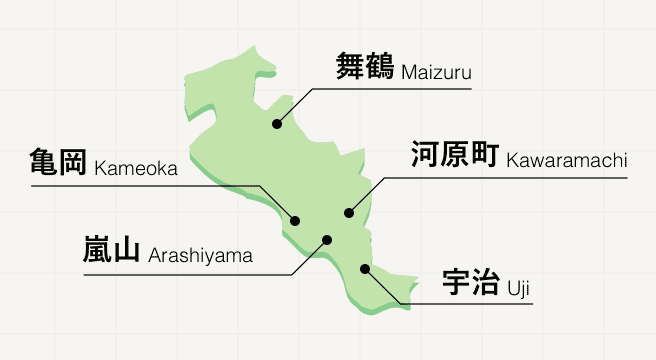Historical Monument Spots in Arashiyama / Sagano / Takao Area
Area
-
-
Kyoto
-
-
Kyoto
-
-
Arashiyama / Sagano / Takao
-
- All areas
- Around Gion
- Around Kiyomizu-Dera Temple
- Around Okazaki
- Around Ginkaku-Ji Temple
- Ichijo-ji Temple / Shugakuin
- Around Fushimi Inari
- Around Kyoto Station
- City Center
- Around Kyoto Imperial Palace
- Around Nishijin
- Around Kamigamo
- Around Kinkaku-Ji Temple
- Uzumasa / Hanazono
- Arashiyama / Sagano / Takao
- Around Mt. Hiei
- Ohara / Kurama / Kifune
- Katsura / Nishiyama
- Yamashina / Daigo
- Around Fushimi
- Around Uji
- Joyo / Yawata
- Kyotanabe / Kizugawa
- Kameoka / Nantan
- Maizuru / Miyazu
-
Arashiyama / Sagano / Takao

Category


-
- Togetsukyo Bridge
- Travel / Tourism
- Kyoto, Kyoto Prefecture Ukyo-ku Arashiyama
- This bridge with a total length of 155 meters spanning the Katsuragawa River offers a vantage point to see the fall foliage of Arashiyama. The bridge is said to have been started by the Jowa-period (834–848) monk Dosho, and the bridge in the current location was built by Suminokura Ryoui in the early Edo period. Togetsukyo Bridge’s name (meaning “the bridge of the passing moon”) is said to have come about when Emperor Kameyama saw a moon move above the bridge and remarked that, “It looks as if the clear moon were walking over the bridge.” The bridge is full of elegance which blends into the landscape of Arashiyama.
-
- Saga-Toriimoto Preserved Street
-
3.515 Reviews
- Travel / Tourism
- Kyoto Kyoto-shi Ukyo-ku Sagatoriimotosennocho 8
- Toriimoto flourished as both a town formed around the Atago Shrine and as an agricultural community. Quite a number of thatched roof dwelling still remain leading to this area being declared a National Group of Traditional Buildings. The archive hall houses a rebuilt and restored dwelling which retains the atmosphere of traditional Toriimoto and has a number of models on display.
-
化野念仏寺のすぐ手前にあります。町家を改装して資料館のようにしていますが、特筆すべき何かがあるわけではないので、立ち寄らなくても大丈夫です。
-
- Rakushisha
- Travel / Tourism
- Kyoto Kyoutoshi Ukyou-ku Sagaogurayamahinomyoujinchou 20
- This is a hermitage of the Genroku period (1688–1704) haiku poet and student of Matsuo Basho, Mukai Kyorai. Kyorai moved into this hut when he was around the age of 35, and it came to be called Rakushisha (the “Hut of Fallen Persimmons”) from around the time he was aged 39. The name comes from the fact that the fruit of 40 persimmon trees in the garden fell down in one night after a storm. Basho wrote his diary “Saga Nikki” here. At the entrance to the thatched hut is an old rain suit and conical hat that belonged to the hut’s owner, and also a box for haiku submissions.
Kyoto Areas

Its wooden tea houses, shuffling geisha, and spiritual sights have seen Kyoto hailed as the heart of traditional Japan, a world apart from ultramodern Tokyo. Despite being the Japanese capital for over a century, Kyoto escaped destruction during World War II, leaving behind a fascinating history which can be felt at every turn, from the fully gold-plated Kinkakuji Temple down to traditional customs such as geisha performances and tea ceremonies, which are still practiced to this day.
Best of Kyoto
Search by Region
-
- Hokkaido / Tohoku
- Hokkaido
- Aomori
- Iwate
- Miyagi
- Akita
- Yamagata
- Fukushima
-
- Kanto
- Ibaraki
- Tochigi
- Gunma
- Saitama
- Chiba
- Tokyo
- Kanagawa
-
- Koshinetsu / Hokuriku
- Niigata
- Toyama
- Ishikawa
- Fukui
- Yamanashi
- Nagano
-
- Tokai
- Gifu
- Shizuoka
- Aichi
- Mie
-
- Kinki
- Shiga
- Kyoto
- Osaka
- Hyogo
- Nara
- Wakayama
-
- Chugoku
- Tottori
- Shimane
- Okayama
- Hiroshima
- Yamaguchi
-
- Shikoku
- Tokushima
- Kagawa
- Ehime
- Kochi
-
- Kyushu / Okinawa
- Fukuoka
- Saga
- Nagasaki
- Kumamoto
- Oita
- Miyazaki
- Kagoshima
- Okinawa















